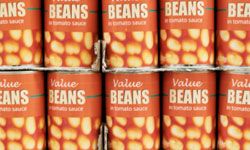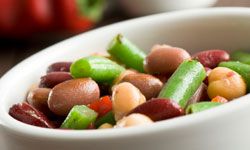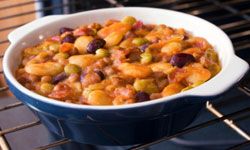“
 “Beans are healthy, affordable and yes, delicious. See more canned and boxed food pictures.Stockbyte/Thinkstock
“Beans are healthy, affordable and yes, delicious. See more canned and boxed food pictures.Stockbyte/Thinkstock
In modern culture, beans are often synonymous with "nothing." But this often-overlooked pantry staple is a powerful source of nutrition. Beans bring plenty of good stuff to the table, including fiber, iron and other minerals and vitamins. Beans also pack enough protein to be an economical stand-in for meat.
Beans aren’t just good for us; they’re good for the earth, too. Wherever beans grow, they build up nitrogen in the soil, making this nutrient available for the next crop that grows there.
Fortunately, since we can’t wait that long for a meal, bean farmers make it easy for us by canning this valuable produce. All that goodness, precooked and ready to use, can be ours with a simple spin of the can opener, and beans can have a starring role in everything from appetizers to desserts. Try one — or all 10 — of these delicious uses for canned beans.
Contents
- Appetizers
- Salads
- Soups
- Casseroles
- Burgers
- A Taste of History
- Salsas
- On the Side
- Potato's Pal
- Sweet Endings
10: Appetizers
Get the party started with a bean dip or two! Whether you’ve got loads of time to prepare for your party or you’re throwing something together on the spur of the moment, you can transform canned beans into an irresistible dip for chips or fresh vegetables.
For a hot bean dip, try Chunky Pinto Bean Dip. It cooks in your slow cooker, leaving you free for other party preparations. If you’re really in a hurry, try Black Bean Dip or Garlic Bean Dip. These don’t need cooking or chilling.
Layered White Bean and Tuna Dip takes a bit more time and effort to put together, but it’s bulked up with veggies. This is hearty appetizer needs a sturdier scooping tool than chips, so serve it with toasted pita bread or slices of a baguette. In fact, this starter is so complete you could serve it as a light meal.
Gassed!
Using canned beans solves the problem of beans potentially being a party pooper. The canning process actually removes some of the sugars that cause digestive gas.
9: Salads
 “
“ “Bean salad tastes even better a day or two after it’s made so the flavors have time to blend.©iStockphoto.com/Daniel Loiselle
“Bean salad tastes even better a day or two after it’s made so the flavors have time to blend.©iStockphoto.com/Daniel Loiselle
Rinsed and chilled, canned beans add nutrition, texture and interest to salads. Toss some garbanzo beans or kidney beans — or whatever canned beans you have in the pantry — into a bowl of greens. Beans can even substitute for croutons in a salad. Just rinse and drain a can of white beans, then fry them in a pan until crispy!
You can skip the lettuce altogether and make beans the basis of your salad. Here are three variations that feature various beans:
- Black Bean Mexicali Salad with a jolt of chipotle and vinegar
- White Bean Salad with Cilantro Vinaigrette for a low-fat starter
- Red Bean and Corn Salad with Lime-Cumin Dressing for color and zing
If you want a nutritious salad you can serve as an entrée, Spicy Orzo and Black Bean Salad fills the bill. On those days when only a warm salad will do, fire up the grill and toss together a Warm Potato and Bean Salad using canned kidney or pinto beans.
8: Soups
Canned beans get to be the star player with bean soup. It makes a hearty, economical dinner for cold winter nights. And beans come in so many different colors and sizes you can make lots of variations of bean soup theme. Try some of these recipes to get you started:
- Fiesta Black Bean Soup for a slow-cooker meal you can set and forget
- Picante Black Bean Soup for a quick-cooking soup
- Winter’s Best Bean Soup, another slow-cooker choice
- Bean Spinach Soup, a vegetarian option
You can also add flavor and texture to your own homemade soup by tossing in a can of seasoned beans. Try chili-seasoned kidney beans in chicken soup or black beans in vegetable soup. Don’t worry about rinsing the beans for these uses because most of the flavor is in the liquid. Some seasoned beans are in a fairly thick liquid, so they’ll thicken your soup, too.
To Rinse or Not to Rinse?
Canned beans have a lot of added salt to help extend their shelf life. To remove some of it, rinse your beans before adding them to your recipe.
7: Casseroles
 “
“ “Think baked beans are limited to hot dogs and hamburgers? Think again.iStockphoto/Thinkstock
“Think baked beans are limited to hot dogs and hamburgers? Think again.iStockphoto/Thinkstock
Sure, you’ve experienced green bean casserole at countless holiday gatherings. But green beans aren’t the only beans with casserole potential. Be original at your next potluck event with a different kind of bean casserole. Imagine the oohs and ahs when you present Caribbean Black Bean Casserole with Spicy Mango Salsa. It’s not just a side dish; it’s a colorful entrée. For a complete vegetarian meal, whip up this Red, White and Black Bean Casserole, or enlist your slow cooker to do the work for a Cornbread and Bean Casserole that cooks up with its own yummy bread topping.
6: Burgers
 “
“ “Kidney, pinto or another firm variety can be swapped for black beans in bean burgers.©iStockphoto.com/Jason Lugo
“Kidney, pinto or another firm variety can be swapped for black beans in bean burgers.©iStockphoto.com/Jason Lugo
Nutritionally, dry beans — beans that are grown for their seeds (like kidney) rather than their pods (like green beans) — compare very favorably with meat. Dry beans deliver appreciable amounts of protein, iron, B vitamins and other nutrients found in meat, but they don’t have the fat and cholesterol that comes with animal protein. Plus, beans infuse your body with disease-fighting antioxidants, complex carbohydrates that help regulate blood sugar and fiber that helps lower cholesterol and keep hunger in check.
So, wouldn’t it be great if beans could masquerade as meat? Well, they can! These Black Bean Burgers are right at home on a bun. Made with canned black beans, each tasty patty has 7 grams of protein, 6 grams of fiber and just 2 grams of fat. Try making ground beef do that!
5: A Taste of History
We all know how important corn was to pre-colonial Native Americans — and to the survival of the Puritan pilgrims at Plymouth Plantation after Squanto taught them how to grow corn. But corn alone didn’t provide enough nutrients to be a mainstay of the Native American diet. Lima beans, frequently planted beside corn so the vines could climb up the corn stalk, were critical for providing protein and nutrients lacking in maize.
Just as the crops grew together, they were boiled together in a dish the Narraganset tribe called "msiquatash," which we know today as succotash. Even in the absence of meat, it met the majority of Native Americans’ nutritional needs.
Native Americans and colonists had to go through a lot of work for a pot of succotash, but by using canned lima beans and corn, you can whip it up in a flash. Add tomatoes, onion, ham or bacon to the mix to bump up the flavor if you like.
To Bean or Not to Bean?
The U.S. Department of Agriculture does not consider green beans, also called string or snap beans, as beans. Green beans’ nutritional content is similar to lettuce, celery, cabbage and onions, so they’re grouped with those vegetables.
4: Salsas
Beans provide an unexpected yet delicious surprise that jazzes up ordinary salsa. This Fresh Tomato-Bean Salsa makes a colorful, delicately flavored topping for polenta that would also be delicious on pita slices. With its flavors of cilantro and lime, Black Bean Salsa is excellent served over grilled chicken or fish. Experiment with different sizes and types of beans to vary the flavor and texture of the final salsa; black-eyed peas are a particular favorite of ours.
Pump Some Iron
All dry beans are generally similar in nutritional content, with the exception of iron. White beans contain nearly twice as much iron as black beans, and kidney beans are between the two [source: Raatz].
3: On the Side
Of course canned beans have always made great side dishes. What’s a cookout without baked beans? Can you imagine a Mexican combo platter without a side of refried beans? But sometimes, it would be nice to take those beans up a notch. Here are some recipes that start with canned beans but end up delivering a more exciting side dish experience:
- Stovetop "Baked" Beans turns up the volume on pork and beans
- Boston Baked Beans transforms canned great northern beans into a rich, savory delight
- Mrs. Grady’s Beans are slow-cooked and hearty enough to make a meal
Canned refried beans are perfectly fine on their own, but you can avoid a lot of added salt and fat when you make your own. You’ll need — what else — canned pinto beans. Rinse and drain the pintos, then mash them with a fork, potato masher or give them a quick blitz in your food processor. Once they’re the consistency you like, add bit of seasoning, spread them into a microwaveable dish and top with shredded cheese. Cover and microwave on medium heat for about 3 minutes for some almost-homemade refried beans.
Color Matters
Vegetables and fruits with deep colors contain higher levels of antioxidants. With 13,727 antioxidants per 1/2-cup serving, red beans are a disease-fighting superstar.
2: Potato's Pal
Next time you fry up a batch of hash brown potatoes, give them a nutritional boost with a can of cannellini beans. Added near the end of cooking, these large, firm, ivory-colored beans blend right in with the potato chunks. They add a pleasant, slightly nutty flavor to hash browns, plus protein and a great big boost of iron. While all dry beans are a good source of iron, white beans have nearly double the iron of black beans.
Think you’ve done all you can with canned beans? Keep reading for more sweet inspiration.
1: Sweet Endings
The U.S. Department of Agriculture recommends that people on a 2,000-calories-a-day diet should eat 3 cups of cooked dry beans each week. But according to The Bean Institute, Americans only eat about a quarter of that amount.
So how can you painlessly increase your intake of beans? Simple. Blend canned navy beans into your next smoothie. Rinse and purée some kidney beans and add them to your breakfast blueberry muffin batter. Tuck smashed black beans into your brownies. Much like applesauce, mashed canned beans can substitute for oil in your baked goods in a 1-to-1 ratio (meaning use 1/2 cup bean purée for 1/2 cup oil, for example). Fruits, nuts and flavorings like vanilla, chocolate and cinnamon in your recipe will cover up any bean taste.
Some Asian desserts use a sweetened paste made from mung beans or red beans to make puddings, dessert soups, pastry fillings and other sweet meal-enders. And while it’s hard for many of us to think of beans as a dessert item, consider this: The two most popular ice cream flavors — vanilla and chocolate — both come from beans.
Find lots more information about food on the next page.
Lots More Information
Related Articles
- 9 Foods That Will Make You Live Forever…Almost
- 10 Superfoods
- Carbohydrate Basics
- How do vegetarians get enough protein?
- How Food Preservation Works
- How many calories does a person need daily?
Sources
- American Bean. "Snacks & Desserts Bean Recipes." 2011. (Oct. 27, 2011) http://americanbean.org/snacks-desserts-bean-recipes/
- Asia Recipe. "Vietnamese Desserts." 2000. (Nov. 2, 2011) http://asiarecipe.com/viedesserts.html
- Cannellini.com. "Cannellini Beans." (Nov. 2, 2011) http://www.cannellini.com/
- Davis, Jeanie Lerche. "Antioxidant Superstars: Vegetables and Beans." WebMD. January 2008. (Oct. 19, 2011) http://www.webmd.com/diet/features/antioxidant-superstars-vegetables-and-beans
- Fat Free Vegan Recipes. "Substitutes and Techniques for Fat Free Cooking." 2011. (Nov. 2, 2011)http://fatfreevegan.com/substitutes-and-techniques-for-fat-free-cooking/
- Food in Every Country. "United States Native Americans." (Oct. 26, 2011) http://www.foodbycountry.com/Spain-to-Zimbabwe-Cumulative-Index/United-States-Native-Americans.html
- Mayo Clinic. "Beans and other legumes: Types and cooking tips." June 16, 2011. (Oct. 20, 2011) http://www.mayoclinic.com/health/legumes/NU00260
- Platt, Marian. "Make succotash a part of your Thanksgiving menu." Sequim Gazette. Nov. 3, 2010. (Oct. 26, 2011) http://www.sequimgazette.com/platt/article.exm/2010-11-03_make_succotash_a_part_of_your_thanksgiving_menu
- Texas Agrilife Extension Service. "Two New Beans from America." Aggie Horticulture. (Oct 25, 2011) http://sustainable.tamu.edu/archives/parsons/publications/vegetabletravelers/beans.html
- The Food Channel. "The Top 15 Most Popular Ice Cream Flavors." July 30, 2008. (Oct. 27, 2011) http://www.foodchannel.com/articles/article/the-top-15-most-popular-ice-cream-flavors/
- U.S. Department of Agriculture. "Foods and Nutrients to Increase." Dietary Guidelines for Americans, 2010. Chapter 4. 2010. (Oct. 27, 2011) http://www.cnpp.usda.gov/Publications/DietaryGuidelines/2010/PolicyDoc/Chapter4.pdf
- U.S. Department of Agriculture. "Starchy Vegetables: Food Pattern Modeling Analysis." Center for Nutrition Policy and Promotion. Appendix E-3.4. (Oct. 26, 2011) http://www.cnpp.usda.gov/Publications/DietaryGuidelines/2010/DGAC/Report/AppendixE-3-4-StarchyVegetables.pdf
- Van Nosdol, Dawn. "Ready or Not #172: Substitute Beans for Oil." A Prepared Home. April 2010. (Nov. 2, 2011) http://apreparedhome.com/ready-or-not/substitute-beans-for-oil/


